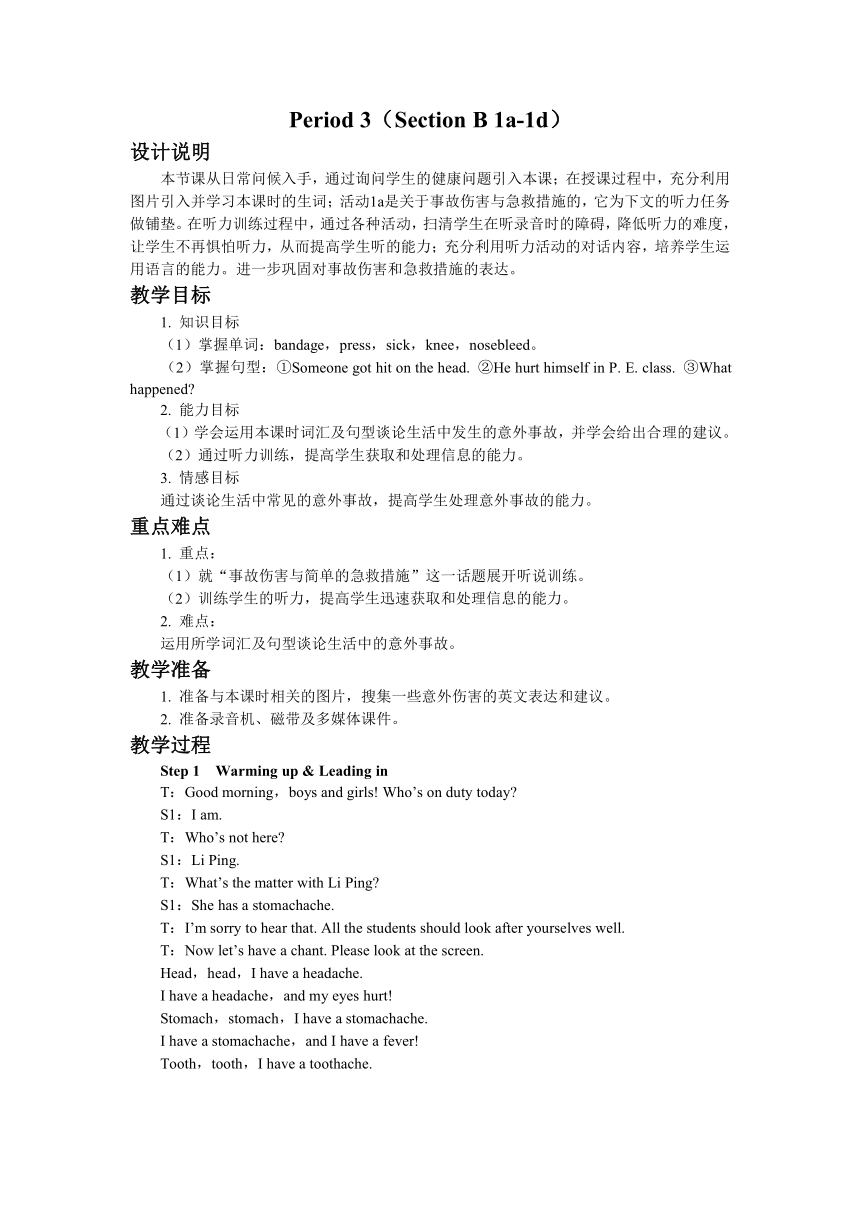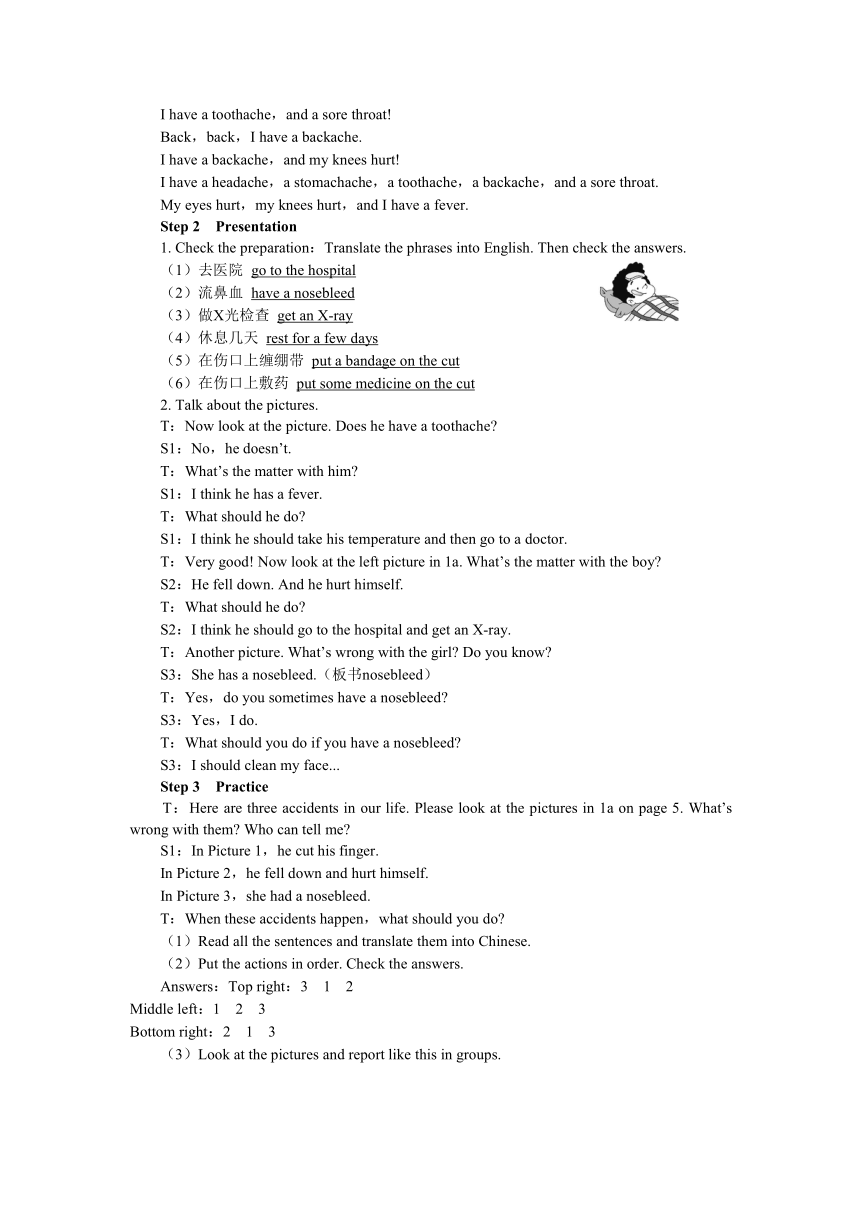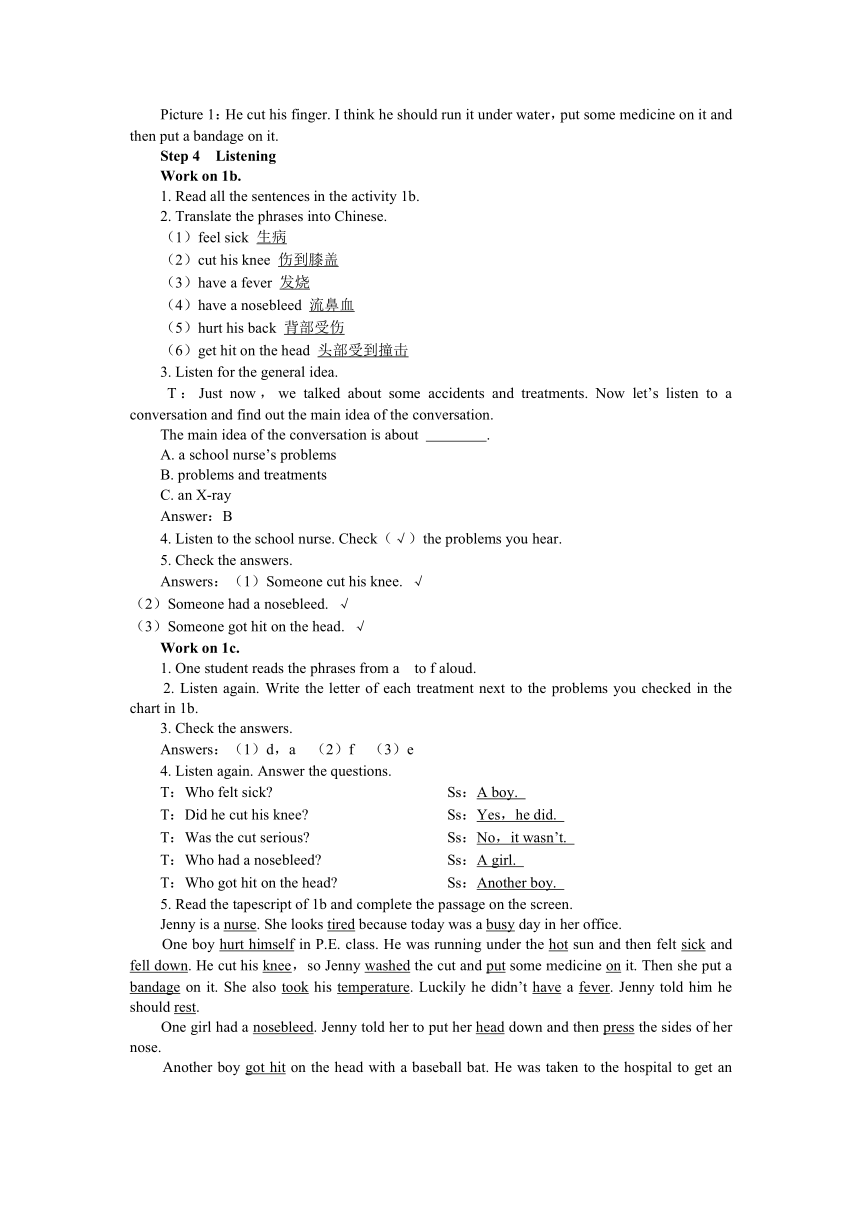UNIT 1 Period 3 (Section B 1a-1d)教学详案
文档属性
| 名称 | UNIT 1 Period 3 (Section B 1a-1d)教学详案 |  | |
| 格式 | docx | ||
| 文件大小 | 113.2KB | ||
| 资源类型 | 试卷 | ||
| 版本资源 | 人教新目标(Go for it)版 | ||
| 科目 | 英语 | ||
| 更新时间 | 2024-02-21 19:33:35 | ||
图片预览



文档简介
Period 3(Section B 1a-1d)
设计说明
本节课从日常问候入手,通过询问学生的健康问题引入本课;在授课过程中,充分利用图片引入并学习本课时的生词;活动1a是关于事故伤害与急救措施的,它为下文的听力任务做铺垫。在听力训练过程中,通过各种活动,扫清学生在听录音时的障碍,降低听力的难度,让学生不再惧怕听力,从而提高学生听的能力;充分利用听力活动的对话内容,培养学生运用语言的能力。进一步巩固对事故伤害和急救措施的表达。
教学目标
1. 知识目标
(1)掌握单词:bandage,press,sick,knee,nosebleed。
(2)掌握句型:①Someone got hit on the head. ②He hurt himself in P. E. class. ③What happened
2. 能力目标
(1)学会运用本课时词汇及句型谈论生活中发生的意外事故,并学会给出合理的建议。
(2)通过听力训练,提高学生获取和处理信息的能力。
3. 情感目标
通过谈论生活中常见的意外事故,提高学生处理意外事故的能力。
重点难点
1. 重点:
(1)就“事故伤害与简单的急救措施”这一话题展开听说训练。
(2)训练学生的听力,提高学生迅速获取和处理信息的能力。
2. 难点:
运用所学词汇及句型谈论生活中的意外事故。
教学准备
1. 准备与本课时相关的图片,搜集一些意外伤害的英文表达和建议。
2. 准备录音机、磁带及多媒体课件。
教学过程
Step 1 Warming up & Leading in
T:Good morning,boys and girls! Who’s on duty today
S1:I am.
T:Who’s not here
S1:Li Ping.
T:What’s the matter with Li Ping
S1:She has a stomachache.
T:I’m sorry to hear that. All the students should look after yourselves well.
T:Now let’s have a chant. Please look at the screen.
Head,head,I have a headache.
I have a headache,and my eyes hurt!
Stomach,stomach,I have a stomachache.
I have a stomachache,and I have a fever!
Tooth,tooth,I have a toothache.
I have a toothache,and a sore throat!
Back,back,I have a backache.
I have a backache,and my knees hurt!
I have a headache,a stomachache,a toothache,a backache,and a sore throat.
My eyes hurt,my knees hurt,and I have a fever.
Step 2 Presentation
1. Check the preparation:Translate the phrases into English. Then check the answers.
(1)去医院 go to the hospital
(2)流鼻血 have a nosebleed
(3)做X光检查 get an X-ray
(4)休息几天 rest for a few days
(5)在伤口上缠绷带 put a bandage on the cut
(6)在伤口上敷药 put some medicine on the cut
2. Talk about the pictures.
T:Now look at the picture. Does he have a toothache
S1:No,he doesn’t.
T:What’s the matter with him
S1:I think he has a fever.
T:What should he do
S1:I think he should take his temperature and then go to a doctor.
T:Very good! Now look at the left picture in 1a. What’s the matter with the boy
S2:He fell down. And he hurt himself.
T:What should he do
S2:I think he should go to the hospital and get an X-ray.
T:Another picture. What’s wrong with the girl Do you know
S3:She has a nosebleed.(板书nosebleed)
T:Yes,do you sometimes have a nosebleed
S3:Yes,I do.
T:What should you do if you have a nosebleed
S3:I should clean my face...
Step 3 Practice
T:Here are three accidents in our life. Please look at the pictures in 1a on page 5. What’s wrong with them Who can tell me
S1:In Picture 1,he cut his finger.
In Picture 2,he fell down and hurt himself.
In Picture 3,she had a nosebleed.
T:When these accidents happen,what should you do
(1)Read all the sentences and translate them into Chinese.
(2)Put the actions in order. Check the answers.
Answers:Top right:3 1 2
Middle left:1 2 3
Bottom right:2 1 3
(3)Look at the pictures and report like this in groups.
Picture 1:He cut his finger. I think he should run it under water,put some medicine on it and then put a bandage on it.
Step 4 Listening
Work on 1b.
1. Read all the sentences in the activity 1b.
2. Translate the phrases into Chinese.
(1)feel sick 生病
(2)cut his knee 伤到膝盖
(3)have a fever 发烧
(4)have a nosebleed 流鼻血
(5)hurt his back 背部受伤
(6)get hit on the head 头部受到撞击
3. Listen for the general idea.
T:Just now,we talked about some accidents and treatments. Now let’s listen to a conversation and find out the main idea of the conversation.
The main idea of the conversation is about .
A. a school nurse’s problems
B. problems and treatments
C. an X-ray
Answer:B
4. Listen to the school nurse. Check(√)the problems you hear.
5. Check the answers.
Answers:(1)Someone cut his knee. √
(2)Someone had a nosebleed. √
(3)Someone got hit on the head. √
Work on 1c.
1. One student reads the phrases from a to f aloud.
2. Listen again. Write the letter of each treatment next to the problems you checked in the chart in 1b.
3. Check the answers.
Answers:(1)d,a (2)f (3)e
4. Listen again. Answer the questions.
T:Who felt sick Ss:A boy.
T:Did he cut his knee Ss:Yes,he did.
T:Was the cut serious Ss:No,it wasn’t.
T:Who had a nosebleed Ss:A girl.
T:Who got hit on the head Ss:Another boy.
5. Read the tapescript of 1b and complete the passage on the screen.
Jenny is a nurse. She looks tired because today was a busy day in her office.
One boy hurt himself in P.E. class. He was running under the hot sun and then felt sick and fell down. He cut his knee,so Jenny washed the cut and put some medicine on it. Then she put a bandage on it. She also took his temperature. Luckily he didn’t have a fever. Jenny told him he should rest.
One girl had a nosebleed. Jenny told her to put her head down and then press the sides of her nose.
Another boy got hit on the head with a baseball bat. He was taken to the hospital to get an X-ray.
Step 5 Group work
1. According to the conversation in 1b,write three passages to introduce the three students’ accidents.
Possible answers:
Passage 1:One boy hurt himself in P. E. class. He was running under the hot sun. And he felt sick and fell down. He cut his knee. The nurse washed the cut,put some medicine and a bandage on it.
Passage 2:One girl had a nosebleed. The nurse told her to put her head down and press the sides of her nose.
Passage 3:Another boy got hit on the head with a base-ball bat. He was taken to the hospital to get an X-ray.
2. Ask two or three groups to read their passages.
Step 6 Pair work(1d)
Role-play a conversation between the nurse and the teacher. Use the information in 1b and 1c.
A:Who came to your office today
B:First,a boy came in. He hurt himself in P. E. class.
A:What happened
B:...
(In this activity,give the students enough time to prepare the conversation.)
Step 7 Cooperative inquiry
Discuss the following language points in groups and fill in the blanks.
1. Someone got hit on the head.
get hit 意为“受到打击”。若表示打在了某人的某个部位,常用结构为:hit sb. + in/on + the +身体部位。in一般用于较软、凹陷的地方,如脸、眼睛等;on则用于较硬、凸出的部位,如鼻子、头等。
The ball hit him in the face(在脸上).
John hit him on the nose(在鼻子上).
2. What happened
happen 意为“发生”,常表示某事偶然发生,主语通常为某事。
常用句式为:①Sth. happens/happened +地点/时间.(某地/某时发生了某事)
昨晚发生了一起火灾。
A fire happened last night.
②Sth. happens/happened to + sb.(某人发生了某事)
昨天她发生了点小意外。
A little accident happened to her yesterday.
③Sb. happen(s)to do sth.(某人碰巧做某事)
我购物时碰巧遇到了我的一位老朋友。
I happened to meet an old friend of mine when I was shopping.
Step 8 Summary
T:What have we learned in this lesson
S1:We have learned the new words—bandage,press,sick,knee,nosebleed.
T:Please translate them into Chinese.
S1:...
当堂达标(见导学案“当堂达标”)
答案与解析:
Ⅰ. 1. nosebleed 句意:曼迪流鼻血,她的连衣裙被弄脏了。have a nosebleed意为“流鼻血”。
2. bandage 句意:我在伤口上敷了点药,然后用绷带把它包扎起来。bandage名词,意为“绷带”。
3. hurt hurt动词,意为“(使)受伤”。句意:我伤害了我最好的朋友——本。因为我说了一些他的 坏话。
4. knee knee名词,意为“膝盖”。句意:他摔倒时膝盖受伤了。
5. hit get hit on the head意为“头部受到撞击”。
Ⅱ.(答案不唯一,仅供参考)
1. You should run it under water,put some medicine on it and put a bandage on it.
2. He should put his head down and then press the sides of his nose.
3. You should take her to the hospital and let her get an X-ray.
Ⅲ. 1. take 该句为祈使句,所以用动词原形take。
2. hurt 由下文“couldn’t move”可知用hurt的过去式hurt。
3. not to speak tell sb. not to do sth. 意为“告诉某人不要做某事”。
4. hit get hit on the head为固定搭配,意为“头部受到撞击”。
Ⅳ. 1. cut yourself cut oneself意为“伤着某人自己”;本句是祈使句,省去了第二人称的主语you。
2. felt/was sick;to rest for a few feel/be sick意为“生病”,根据told可知句子时态为一般过去时;tell sb. to do sth. 意为“告诉某人做某事”。
3. take him,to get take sb. to...意为“把某人带到……”;get an X-ray意为“做X光检查”。第三、四个空处表目的,故用动词不定式to get。
4. happened to Sth. happens/happened to sb. 意为“某人发生了某事”。
Step 9 Homework
1. Read and copy the new words of this lesson.
2. Read 1b after the tape.
板书设计
UNIT 1 What’s the matter Period 3(Section B 1a-1d)
bandage press sick knee nosebleed
教学反思
设计说明
本节课从日常问候入手,通过询问学生的健康问题引入本课;在授课过程中,充分利用图片引入并学习本课时的生词;活动1a是关于事故伤害与急救措施的,它为下文的听力任务做铺垫。在听力训练过程中,通过各种活动,扫清学生在听录音时的障碍,降低听力的难度,让学生不再惧怕听力,从而提高学生听的能力;充分利用听力活动的对话内容,培养学生运用语言的能力。进一步巩固对事故伤害和急救措施的表达。
教学目标
1. 知识目标
(1)掌握单词:bandage,press,sick,knee,nosebleed。
(2)掌握句型:①Someone got hit on the head. ②He hurt himself in P. E. class. ③What happened
2. 能力目标
(1)学会运用本课时词汇及句型谈论生活中发生的意外事故,并学会给出合理的建议。
(2)通过听力训练,提高学生获取和处理信息的能力。
3. 情感目标
通过谈论生活中常见的意外事故,提高学生处理意外事故的能力。
重点难点
1. 重点:
(1)就“事故伤害与简单的急救措施”这一话题展开听说训练。
(2)训练学生的听力,提高学生迅速获取和处理信息的能力。
2. 难点:
运用所学词汇及句型谈论生活中的意外事故。
教学准备
1. 准备与本课时相关的图片,搜集一些意外伤害的英文表达和建议。
2. 准备录音机、磁带及多媒体课件。
教学过程
Step 1 Warming up & Leading in
T:Good morning,boys and girls! Who’s on duty today
S1:I am.
T:Who’s not here
S1:Li Ping.
T:What’s the matter with Li Ping
S1:She has a stomachache.
T:I’m sorry to hear that. All the students should look after yourselves well.
T:Now let’s have a chant. Please look at the screen.
Head,head,I have a headache.
I have a headache,and my eyes hurt!
Stomach,stomach,I have a stomachache.
I have a stomachache,and I have a fever!
Tooth,tooth,I have a toothache.
I have a toothache,and a sore throat!
Back,back,I have a backache.
I have a backache,and my knees hurt!
I have a headache,a stomachache,a toothache,a backache,and a sore throat.
My eyes hurt,my knees hurt,and I have a fever.
Step 2 Presentation
1. Check the preparation:Translate the phrases into English. Then check the answers.
(1)去医院 go to the hospital
(2)流鼻血 have a nosebleed
(3)做X光检查 get an X-ray
(4)休息几天 rest for a few days
(5)在伤口上缠绷带 put a bandage on the cut
(6)在伤口上敷药 put some medicine on the cut
2. Talk about the pictures.
T:Now look at the picture. Does he have a toothache
S1:No,he doesn’t.
T:What’s the matter with him
S1:I think he has a fever.
T:What should he do
S1:I think he should take his temperature and then go to a doctor.
T:Very good! Now look at the left picture in 1a. What’s the matter with the boy
S2:He fell down. And he hurt himself.
T:What should he do
S2:I think he should go to the hospital and get an X-ray.
T:Another picture. What’s wrong with the girl Do you know
S3:She has a nosebleed.(板书nosebleed)
T:Yes,do you sometimes have a nosebleed
S3:Yes,I do.
T:What should you do if you have a nosebleed
S3:I should clean my face...
Step 3 Practice
T:Here are three accidents in our life. Please look at the pictures in 1a on page 5. What’s wrong with them Who can tell me
S1:In Picture 1,he cut his finger.
In Picture 2,he fell down and hurt himself.
In Picture 3,she had a nosebleed.
T:When these accidents happen,what should you do
(1)Read all the sentences and translate them into Chinese.
(2)Put the actions in order. Check the answers.
Answers:Top right:3 1 2
Middle left:1 2 3
Bottom right:2 1 3
(3)Look at the pictures and report like this in groups.
Picture 1:He cut his finger. I think he should run it under water,put some medicine on it and then put a bandage on it.
Step 4 Listening
Work on 1b.
1. Read all the sentences in the activity 1b.
2. Translate the phrases into Chinese.
(1)feel sick 生病
(2)cut his knee 伤到膝盖
(3)have a fever 发烧
(4)have a nosebleed 流鼻血
(5)hurt his back 背部受伤
(6)get hit on the head 头部受到撞击
3. Listen for the general idea.
T:Just now,we talked about some accidents and treatments. Now let’s listen to a conversation and find out the main idea of the conversation.
The main idea of the conversation is about .
A. a school nurse’s problems
B. problems and treatments
C. an X-ray
Answer:B
4. Listen to the school nurse. Check(√)the problems you hear.
5. Check the answers.
Answers:(1)Someone cut his knee. √
(2)Someone had a nosebleed. √
(3)Someone got hit on the head. √
Work on 1c.
1. One student reads the phrases from a to f aloud.
2. Listen again. Write the letter of each treatment next to the problems you checked in the chart in 1b.
3. Check the answers.
Answers:(1)d,a (2)f (3)e
4. Listen again. Answer the questions.
T:Who felt sick Ss:A boy.
T:Did he cut his knee Ss:Yes,he did.
T:Was the cut serious Ss:No,it wasn’t.
T:Who had a nosebleed Ss:A girl.
T:Who got hit on the head Ss:Another boy.
5. Read the tapescript of 1b and complete the passage on the screen.
Jenny is a nurse. She looks tired because today was a busy day in her office.
One boy hurt himself in P.E. class. He was running under the hot sun and then felt sick and fell down. He cut his knee,so Jenny washed the cut and put some medicine on it. Then she put a bandage on it. She also took his temperature. Luckily he didn’t have a fever. Jenny told him he should rest.
One girl had a nosebleed. Jenny told her to put her head down and then press the sides of her nose.
Another boy got hit on the head with a baseball bat. He was taken to the hospital to get an X-ray.
Step 5 Group work
1. According to the conversation in 1b,write three passages to introduce the three students’ accidents.
Possible answers:
Passage 1:One boy hurt himself in P. E. class. He was running under the hot sun. And he felt sick and fell down. He cut his knee. The nurse washed the cut,put some medicine and a bandage on it.
Passage 2:One girl had a nosebleed. The nurse told her to put her head down and press the sides of her nose.
Passage 3:Another boy got hit on the head with a base-ball bat. He was taken to the hospital to get an X-ray.
2. Ask two or three groups to read their passages.
Step 6 Pair work(1d)
Role-play a conversation between the nurse and the teacher. Use the information in 1b and 1c.
A:Who came to your office today
B:First,a boy came in. He hurt himself in P. E. class.
A:What happened
B:...
(In this activity,give the students enough time to prepare the conversation.)
Step 7 Cooperative inquiry
Discuss the following language points in groups and fill in the blanks.
1. Someone got hit on the head.
get hit 意为“受到打击”。若表示打在了某人的某个部位,常用结构为:hit sb. + in/on + the +身体部位。in一般用于较软、凹陷的地方,如脸、眼睛等;on则用于较硬、凸出的部位,如鼻子、头等。
The ball hit him in the face(在脸上).
John hit him on the nose(在鼻子上).
2. What happened
happen 意为“发生”,常表示某事偶然发生,主语通常为某事。
常用句式为:①Sth. happens/happened +地点/时间.(某地/某时发生了某事)
昨晚发生了一起火灾。
A fire happened last night.
②Sth. happens/happened to + sb.(某人发生了某事)
昨天她发生了点小意外。
A little accident happened to her yesterday.
③Sb. happen(s)to do sth.(某人碰巧做某事)
我购物时碰巧遇到了我的一位老朋友。
I happened to meet an old friend of mine when I was shopping.
Step 8 Summary
T:What have we learned in this lesson
S1:We have learned the new words—bandage,press,sick,knee,nosebleed.
T:Please translate them into Chinese.
S1:...
当堂达标(见导学案“当堂达标”)
答案与解析:
Ⅰ. 1. nosebleed 句意:曼迪流鼻血,她的连衣裙被弄脏了。have a nosebleed意为“流鼻血”。
2. bandage 句意:我在伤口上敷了点药,然后用绷带把它包扎起来。bandage名词,意为“绷带”。
3. hurt hurt动词,意为“(使)受伤”。句意:我伤害了我最好的朋友——本。因为我说了一些他的 坏话。
4. knee knee名词,意为“膝盖”。句意:他摔倒时膝盖受伤了。
5. hit get hit on the head意为“头部受到撞击”。
Ⅱ.(答案不唯一,仅供参考)
1. You should run it under water,put some medicine on it and put a bandage on it.
2. He should put his head down and then press the sides of his nose.
3. You should take her to the hospital and let her get an X-ray.
Ⅲ. 1. take 该句为祈使句,所以用动词原形take。
2. hurt 由下文“couldn’t move”可知用hurt的过去式hurt。
3. not to speak tell sb. not to do sth. 意为“告诉某人不要做某事”。
4. hit get hit on the head为固定搭配,意为“头部受到撞击”。
Ⅳ. 1. cut yourself cut oneself意为“伤着某人自己”;本句是祈使句,省去了第二人称的主语you。
2. felt/was sick;to rest for a few feel/be sick意为“生病”,根据told可知句子时态为一般过去时;tell sb. to do sth. 意为“告诉某人做某事”。
3. take him,to get take sb. to...意为“把某人带到……”;get an X-ray意为“做X光检查”。第三、四个空处表目的,故用动词不定式to get。
4. happened to Sth. happens/happened to sb. 意为“某人发生了某事”。
Step 9 Homework
1. Read and copy the new words of this lesson.
2. Read 1b after the tape.
板书设计
UNIT 1 What’s the matter Period 3(Section B 1a-1d)
bandage press sick knee nosebleed
教学反思
同课章节目录
- Unit 1 What's the matter?
- Section A
- Section B
- Unit 2 I'll help to clean up the city parks.
- Section A
- Section B
- Unit 3 Could you please clean your room?
- Section A
- Section B
- Unit 4 Why don't you talk to your parents?
- Section A
- Section B
- Unit 5 What were you doing when the rainstorm came
- Section A
- Section B
- Review of Units 1-5
- Unit 6 An old man tried to move the mountains.
- Section A
- Section B
- Unit 7 What's the highest mountain in the world?
- Section A
- Section B
- Unit 8 Have you read Treasure Island yet?
- Section A
- Section B
- Unit 9 Have you ever been to a museum?
- Section A
- Section B
- Unit 10 I've had this bike for three years.
- Section A
- Section B
